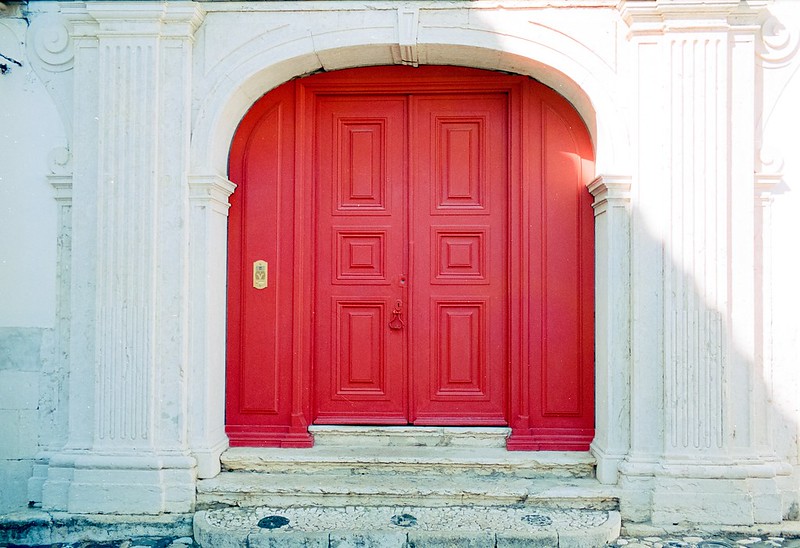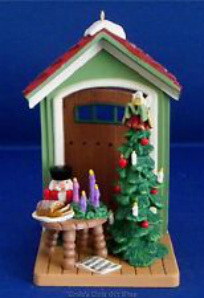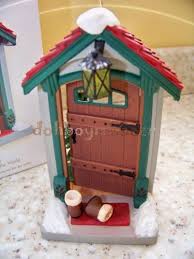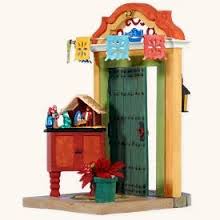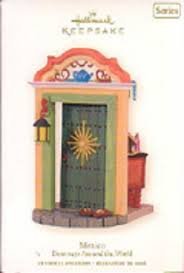We are Doorway People
|
|
Form: The first thing to notice about the German ornament is it's architecture. The steep roof line and heavy tiles indicate that this is a household prepared for heavy, long winters. In fact, the center ridge of the roof is laden with snow, and there is more snow on each side of the doormat. The wood frame of the front door reveals the woodworking abilities of the northern European countries. The carvings on the base of each side of the door are similar to decorations from Denmark, Sweden, Norway and Finland. This type of woodwork is also seen in Disney's movie Snow White and the Seven Dwarves, for example, in the woodcutter's cottage.
Ornament Visual Tour
Ornament Visual Tour
- the nutcracker: The tradition of the nutcracker began in Germany, as is seen in the small town called Rothenburg-ob-der-Tauber, frequently referred to today as "Christmas Town." (For more info about this lovely, Medieval town, visit this link: http://www.germanplaces.com/germany/rothenburg-ob-der-tauber.html Although various types of nutcrackers have been around for thousands of years, the Christmas nutcracker began in Germany, as a result of the novelette "The Nutcracker and the Mouse King," written by E.T.A. Hoffman, an influential German writer belonging to the Romantic movement. This short story is the basis for Tschaichovsky's ballet "The Nutcracker," known around the world. Just as portrayed in the ballet, the Christmas nutcracker is a symbol of strength, loyalty and self-discipline.
- the table: The table is actually a four-legged milking stool, pointing to Germany's agrarian history, but also to the number "four," which in Judaic symbolism refers to "wholeness," or "completeness." The number four is frequently used in the Bible, for example, the 40 years of wandering in the desert, Christ's 40 days in the desert. Additionally, milk refers to new life, as in " a land flowing with milk and honey." In this case, the new life ushered in by the birth of Jesus.
- the stollen cake: Stollen is the traditional German Christmas bread. It is typically loaded with nuts and fruit, and often sugared on top. Similar to the English fruitcake, stollen is usually sweeter and may also contain a marzipan filling. Many countries have a special bread that is reserved for the holy days at Christmas. The bread was used to mark a special event, as well as for sustanence. It was meant to help the faithful connect the movement of holy days in the Liturgical year with the bread they received at Mass; a celebration of the work of salvation already completed by Christ, as well as a foreshadowing of the bountiful life yet to come. It is well worth making yourself. Try this receipe: http://allrecipes.com/recipe/christmas-stollen/detail.aspx
- the Advent wreath: This traditional symbol of Christmas is used to count-down the four weeks before December 25, and is seen in churches all over the world during Advent. Like the milking stool, the number "4" in the four candles is a reference to wholeness, here meaning that Christ came for the entire world. The candles represent the illumination he brings, as well as a call to prepare for his birth. The three purple candles represent a certain serious and solemnity of the days, in a call to reflection and meditation of our own behavior and how we are called to prepare our hearts to receive him. The pink candle marks "Gaudete Sunday," a pause in the seriousness, to remind us that the birth of Christ has, in fact, already taken place in history, and we are filled with joy. Finally, the circular base of the wreath is a symbol of eternity, while the evergreens represent triumph, both of Christ's victory over death as well as that of those who follow him.
- the "Stille Nacht" musicsheet: This well-known Christmas hymn was originally composed in German by Fr. Joseph Mohr in 1816, and set to music by Franz Gruber. Today, the hymn is in the public domain. Click here to hear a version of it: www.http://www.carols.org.uk/silent_night.htm This simple hymn is truly known the entire world over. It has been translated into virtually every language on earth, and even some not on earth, such as Klingon (from the Star Trek tv series) and Grey Elven (from (J.R.R. Tolkien's "Lord of the Rings" trilogy) Click here to read those versions: http://www.silentnight.web.za/translate/
- the Christmas tree: The tradition of the Christmas tree began in Germany, and is usually attributed to the efforts of St. Boniface, as he taught Christianity. The legend goes that evergreen trees were used in Druidic rituals of rebirth. Many cultures have conducted rites around evergreens. These earlier peoples noticed that, despite the brutal winter elements of cold and snow, some trees seemed to be completely unaffected. They took this to mean that there was a certain magic associated with these trees, a power of life over death. Possibly this even meant a god or deity resided in these trees, giving them the god's own life force. In Germany, trees were particularly associated with the god Thor. But St. Boniface is remembered for challenging this belief by cutting down Thor's "holy tree," and using the wood to build a chapel. Years later, Martin Luther also encouraged the use of the Christmas tree, as a symbol of the Tree of Life from the Garden of Eden. The Christmas tree usually has a star, representing the Star of Bethlehem, or an angel, recalling the angels who appeared to the shepherds, at the tip. The first decorations were apples, recalling the sin of Adam and Eve, pears, referencing Mary, who would give birth to the Savior, and candles, announcing the birth of the light of the world, Christ. Over time, decorations became more elaborate, yet still, Christmas ornaments remain laden with meaning.
Form: The architecture in this ornament is very different from the German ornament. The bright colors on and around the front door (yellow, dark green, light green and terracotta) immediately call to mind the brightly painted houses found throughout Latin America. The open decorative area above the door reminds us of the warm temperature throughout much of Mexico, and that houses are built with pathways for breezes to flow from one side of the house to the other. The door in the ornament is very thick and heavy, and may actually open into a small courtyard, filled with tropical plants.
Ornament Visual Tour:
Ornament Visual Tour:
- the blue teapot over the door: a universal symbol for hospitality, is most likely full of chamomile, or "manzanilla" tea. Chamomile tea is used often in Hispanic cultures for mild illness, such as upset stomach or tension, as well as an expression of hospitality and peace to the guest. At this house, the teapot also designates the household as the final stop of the nine-day Posada. Las Posadas is a community celebration and re-enactment of Mary and Joseph's attempt to find lodging in Bethlemhem. Read more about this tradition here: http://en.wikipedia.org/wiki/Las_Posadas. Another tradition possibly happening in this home is the Christmas novena. Friends, family and neighbors are all invited to the host's home for each of the nine days before Christmas, beginning on Dec. 16 and ending on December 25, with Midnight Mass. During the novena, the group prays together and sings traditional Spanish hymns, like "Ven, Ven, Ven" and "Noche de Paz." Typically, children and adults alike are handed a small musical instrument, like a tambourine or a maraca, to accompany the singing. Afterwards, everyone has a small snack, like cookies and ice cream. On Christmas Eve, however, the big Christmas meal might be enjoyed, since everyone will be up late for Midnight Mass.
- the star on the door: the big star on the front door is made out of straw, and symbolizes not only the Star of Bethlehem which led the 3 Wise Men to Jesus, but it also means that the house follows Christ, and that he will be found here as well. Many Hispanic homes have a picture of the Christ child with his arms outstretched in blessing, with the words "Yo Reinare" over head. Click here to see the most common statue: http://www.discountcatholicstore.com/images/XL/HC9-031S.jpgStraw is often used as part of hispanic Christmas decorating, as it refers to the straw in the manger where Jesus was laid. In some places, children put a piece of straw in the manager for each good deed done during Advent. Straw also is a reference to the 3 Wise Men, who feed their animals plenty of hay along the journey. The star and straw are both used to symbolize preparation, an interior journey done alongside the kings, so that the Christ child is properly welcomed.
- the papel picado hanging inside the door: papel picado literally means "punched paper" and is a form of paper cutting that has highly evolved in Mexico and hispanic cultures. Papel picado is especially seen around Christmastime, beginning with the feast of Our Lady of Guadalupe on December 12, when many churches string the paper outside, as well as other festival days like Day of the Dead. Many homes in San Antonio, Texas, display papel picado during Fiesta Week, in the spring. (Click here to see a picture: http://sweetchicken.stlouisblogs.org/P4200193.JPG Making papel picado is a good activity to do with groups, as it's inexpensive, quick and very dramatic. Click here to learn more about this folk art and how to do it: http://www.internationalfolkart.org/eventsedu/education/muertos/papelpicado.htmlAs a side note, the art of cutting paper is seen in several cultures around the world, but each culture has developed it's own particular "look." In Germany, paper cutting is called "scherenschnitte," and does not usually include the edges of the paper. View an example here:https://www.ansichtskarten-center.de/webshop/shop/ProdukteBilder/14036/AK_12017692_kl_1.jpg In Poland, the form is called "wycinanki," and is often multi-colored. View an example here, at the Polish American Center: www.polishamericancenter.org/Wycinanki.htm Finally, paper cutting in France is referred to as "silhouettes." This is the type of paper art most of us have seen: http://www.vintagemint.com/wp-content/uploads/silhouette_art_country_living4.jpg
- the creche: Traditional tells us that St. Francis began the custom of the nativity scene. He wanted to assist people in meditating and being part of the birth of Christ, so he gathered some volunteers and animals and set up a representation of that holy night. Since then, the custom has changed into primarily smaller nativity scenes that are placed in individual homes. In many hispanic homes, Nino Dios (Baby Jesus) may bring one or two small gifts on Christmas morning, but it is not until the feast of the Epiphany, twelve days later, that the 3 Kings deliver all the gifts. This custom was in imitation of the 3 gifts that the kings brought: gold, for a king, myrrh, for a victim, and frankincense, for a god. The church considers the feast of the Epiphany to be the day that Jesus was introduced to the world. This was to fulfill the prophecy that salvation would come from the Jews, represented by the shepherds, Mary and Joseph, who were the first to behold Christ, but then the good news would spread to the ends of the earth, represented by the kings who came from foreign lands. Although the nativity scene in the ornament is quite small and simple, it is not uncommon for nativity scenes to fill entire rooms with highly detailed scenes, including paper mache caves and hills. Some scenes even have running water!
- the table: this little table is a classic example of furniture found in Mexican homes. The turned wooden legs and two color stains are common, and recall Mexico's carpentry tradition. The cupboard doors close tightly, as furniture is not left open due to the large amount of dust in the air. Like the milking stool in the German ornament, this table has four legs. As Christians, we remember the Judaic meaning of the number four, a worldwide embrace, a completeness.
- the poinsettia plant: Although a tropical plant, the poinsttia has become a symbol for Christmas, especially in the Americas. Native to Mexico, the plant was named in honor of Joel Roberts Poinsett, the first United States Ambassador to Mexico. Known as "star flower" to the native people, poinettias today are recognized around the world for their beauty. Check out the "Poinsettia Pages" from University of Illinois Extension for facts and care about the poinsettia:http://urbanext.illinois.edu/poinsettia/index.cfm Today, the poinsettia is also well-known due to the Mexican folktale "The Legend of the Poinsettia." There are many different versions of this tale, but here is one: http://www.ecke.com/html/h_corp/corp_legend.html

